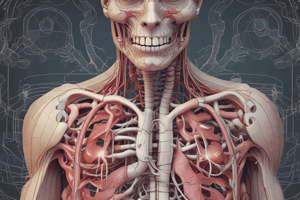Podcast
Questions and Answers
Where does the 4th part of the small intestine lead to?
Where does the 4th part of the small intestine lead to?
- Ileum
- Duodenum
- Caecum
- Jejunum (correct)
What is the length of the jejunum?
What is the length of the jejunum?
- 5m
- 2.5m (correct)
- 4m
- 3m
What is the function of enterocytes in the small intestine?
What is the function of enterocytes in the small intestine?
- Producing mucus
- Providing innate immunity
- Regulating gut motility
- Absorbing nutrients (correct)
Where are duodenal glands concentrated?
Where are duodenal glands concentrated?
What is a characteristic feature of the jejunum and ileum?
What is a characteristic feature of the jejunum and ileum?
What is the location of most of the jejunum?
What is the location of most of the jejunum?
What is the primary function of the caecum in the digestive system?
What is the primary function of the caecum in the digestive system?
Which of the following accurately describes the structure of the appendix?
Which of the following accurately describes the structure of the appendix?
Which of the following is NOT a primary function of the rectum and anal canal?
Which of the following is NOT a primary function of the rectum and anal canal?
What is the characteristic feature of the colon that distinguishes it from the small intestine?
What is the characteristic feature of the colon that distinguishes it from the small intestine?
Which of the following cell types is NOT found in the lower GI histology?
Which of the following cell types is NOT found in the lower GI histology?
What is the primary function of goblet cells in the lower GI tract?
What is the primary function of goblet cells in the lower GI tract?
What is the clinical significance of the taeniae coli, the longitudinal muscle bands in the colon?
What is the clinical significance of the taeniae coli, the longitudinal muscle bands in the colon?
What is the function of the epiploic appendages found in the colon?
What is the function of the epiploic appendages found in the colon?
Study Notes
Functional Anatomy of the Digestive Tract
- The digestive tract consists of the oral cavity, oesophagus, stomach, duodenum, jejunum, ileum, caecum, and colon.
- Accessory digestive organs include salivary glands, liver, gallbladder, pancreas, and the spleen.
Small Intestine
- Duodenum:
- Location: begins at the pyloric sphincter of the stomach
- Shape: C-shaped
- Parts: 4 parts, including the descending, horizontal, ascending, and 4th part
- Relations: surrounded by the liver, gallbladder, and pancreas
- Derivatives of the primitive midgut begin from the distal half of the 2nd part of the duodenum
- Jejunum:
- Location: lies in the left upper quadrant
- Length: 2.5m
- Width: 2-4cm
- Parts: none
- Relations: surrounded by the jejunum and ileum
- Internal features: plicae circulares, simple columnar epithelium, villi, microvilli, goblet cells, enterocytes, and Paneth cells
- Payer's patch initiate/ trigger immune responses (like lymphocytes)
- Circular folds are most prominent
- Ileum:
- Location: lies in the right lower quadrant
- Length: 3m
- Width: 2-3cm
- Parts: none
- Relations: surrounded by the jejunum and ileum
- Internal features: plicae circulares, simple columnar epithelium, villi, microvilli, goblet cells, enterocytes, and Paneth cells
- Payer's patch most prominent
- Histology:
- Plicae circulares
- Simple columnar epithelium
- Villi
- Microvilli
- Goblet cells
- Enterocytes (absorb nutrients)
- Paneth cells (innate immunity)
Duodenal (Brunner) Glands
- Location: concentrated in the upper duodenum
- Function: produce mucus to protect the duodenum from digestive enzymes
Additional Resources
- Gray's Anatomy for Students
- Abrahams' and McMinn's Clinical Atlas of Human Anatomy
- Complete Anatomy
- Wheater's Functional Histology: A Text and Colour Atlas
LARGE INTESTINE:
Studying That Suits You
Use AI to generate personalized quizzes and flashcards to suit your learning preferences.
Related Documents
Description
This quiz covers the gross and microanatomy of the gastrointestinal tract, including its function and structure. It is part of the UM1010 GI Block course taught by Dr. Anthony Adefolaju.




